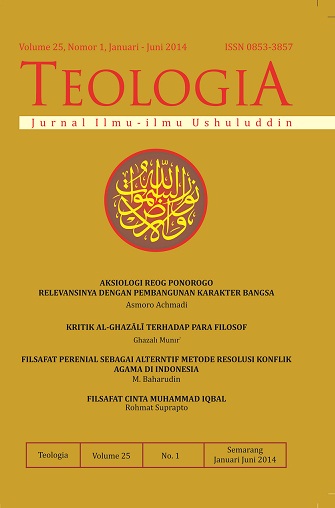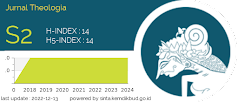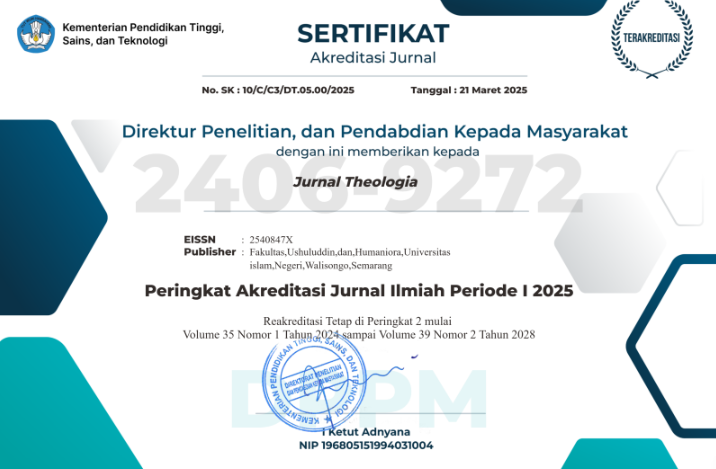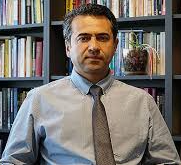INSĀN KĀMIL: ANTARA MITOS DAN REALITAS
DOI:
https://doi.org/10.21580/teo.2014.25.1.343Abstract
Abstract: Islam as a religion delivered by Muhammad saw. bin Abdullah (w.632) is based on the revelations he received from God. At the end of his age, the religion is stated as a perfect religion because it contains a description of all aspects of life (tibyanan likulli syai'). To become the most religionist in Islam, every Moslem should follow the religious way he was because he is a good example (uswatun hasanah), especially the religious rituals dimension. The implication is clear that looking for other models of religious practices except him are certainly would not be the best because there is no guarantee of truth. Over time, many factors occur in the dynamics of the history of Moslem. The values of Islam built by the Messenger have changed a lot in the society. Muhammad position as the top model has shifted into the lower one. The concept of insān kāmil (perfect man) pops out then. They are also the 'loyal followers' of the Messenger of Allah, introducing the idea of speculative-philosophical-mystical religious rituals and a very extreme and radical practice of religious rituals if measured from his norm and religious practices. Nevertheless, the mass movement of Moslem under the shadow of the perfect man considered as something between a myth and reality refer to the texts of the Quran and al-sunnah. Abstrak: Islam sebagai agama disampaikankan oleh Muhammad saw. bin Abdullah (w.632) atas dasar wahyu yang ia terima dari Tuhan. Pada usia akhir-akhir hayatnya, agama ini dinyatakan sebagai agama yang sempurna karena memang mengandung penjelasan semua aspek kehidupan (tibyanan likulli syai’). Untuk menjadi agamawan yang paling baik di dalam Islam, setiap muslim supaya mengikuti cara ia ber¬agama karena ia adalah contoh yang baik (uswatun hasanah), khususnya dimensi ritual keagamaan. Implikasinya mencari model praktik-praktik keberagamaan selain beliau tentu tidak akan menjadi yang paling baik karena tidak ada jaminan kebenarannya. Seiring perjalanan waktu, banyak faktor terjadi dalam dinamika sejarah umat Islam.Nilai-nilai yang dibangun oleh pembawa Islam pun banyak yang berubah. Posisi Muhammad saw. sebagai top model dalam beragama tergeser pada peringkat yang lebih rendah. Konsep insān kāmil bermunculan. Mereka yang juga ‘pengikut setia’ Rasulullah, memper¬kenalkan gagasan spekulatif-filosofis-mitis dan praktik ritual keagamaan yang sangat eks¬trim dan radikal jika diukur dari norma dan praktik keberagamaan beliau. Meski¬pun demikian, gerakan massal umat Islam di bawah bayang-bayang insān kāmil yang jika ditimbang dengan neraca teks-teks al-Quran maupun al-sunnah dapat dinyatakan sebagai sesuatu antara mitos atau realitas. Keywords:uswatun hasanah, penggeseran nilai, insān kāmil, praktik keberagamaan, mitos.Downloads
References
Abd. Haq Anshari, Muhammad, Antara Sufisme dan Syari’ah, Jakarta: Rajawali Pers, 1986.
al-‘Asqalani, Ibn Hajar, Bulugh al-Maram, terj. Ahmad Sunarto, Jakarta: Pustaka Amani, 2000.
Altizer, Thomas J.J., Toward a New Christianity:Reading in the Death of God Theologgy, New York:Harcourt, Brace & Word Inc., 1967.
Danusiri, “Pengalaman Mistik Pengikut Tarekat Qadiriyah wa Naqsyabandiyah Dawe Kudus,” dalam Analisa, Volume19, No 01, 2012.
Ghazālī, Abū Ḥāmid Ibn Muḥammad Ibn Muḥammad, al-Munqiẓ min al-Ḍalāl. Damascus: t.p., 1934.
Haddad, al-Habib Alwi b. Thahir, Wali, Karamah & Thariqah, Jakarta: Hayat Publishing, 2007.
Hart, Michael, 100 a Ranking of the Most Influential Persons in History, (terj.) Mahbub Djunaidi: Seratus Tokoh yang Paling Berpengaruh Dalam Sejarah. Jakarta: Pustaka, 1988.
Ibn ‘Arabī, Muḥyi al-Dīn, ‘Uqlat al-Mustawfiḍ, dalam H.S. Nyberg, Klienere Schriften des Ibn ‘Arabi. Leiden: E.J.Brill, 1914.
Ibn ‘Arabī, Muḥyi al-Dīn, al-Futuḥāt al-Makiyyah, Beirūt: Dār al-Fikr, t.th.
Ibn ‘Arabī, Muḥyi al-Dīn, al-Tadbīrāt al-Ilāhiyah fī Iṣlaḥ al-Mamlakah al-Insāniyyah, Dalam H.S.Neyberg, Klienere Schriften des Ibn ‘Arabi. Lieden: E.J. Brill, 1919.
Ibn ‘Arabī, Muḥyi al-Dīn, Fuṣūṣ al-Ḥikam, (ed) Abū ‘Ala ‘Afifi, Kairo: Dār Iḥyā’ al-Kutub al-‘Arabiyah, 1946.
Jīlī, ‘Abd al-Karīm ibn Ibrāhīm, al-Insān al-Kāmil fi ma’rifat al-Awākhir wa’l-Awā’il, Beirūt: Dār al-Fikr, 1975.
Khon, Abdul Majid, Ulumul Hadis, Jakarta: Amzah, 2012.
Mahmudunnasir, Syed, Islam: Konsepsi dan Sejarahnya, terj. AdangAfandi, Bandung: Rosdakarya, 1988.
Mustiningsih, Wahyu, Para Filsuf dari Plato Sampai Ibnu Bajjah. Jogjakarata: IRSiSoD., 2012.
Nasution, Harun, Pembaharuandalam Islam, Jakarta: BulanBintang, 1975.
Nasution, Harun, Falsafat dan Mistisisme dalam Islam, Jakarta: BulanBintang, 1978.
Peursen, C.A.Van, Orientasi di Alam Filsafat, Jakarta: Gramedia, 1985.
Russel, Bertrand, Sejarah Filsafat Barat, terj. Sigit Jatmiko, Yogyakarta: Pustaka Pelajar, 2007.
Sidiq, RisalāhNail al-AmānifīŻikrManāqib al-Rabbāni al-Syaikh ‘Abd al-Qādir al-Jīlani, Kudus: t.p., 1981.
Simon, Hasanu, Misteri Syekh Siti Jenar, Yogyakarta: Pustaka Pelajar, 2006.
Soekadijo, R.G., LogikaDasar: Tradisional, Simbolik, dan Induktif, Jakarta: Gramedia, 1983.
Soetriono dan Rita Hanafi, FilsafatIlmu dan MetodologiPenelitian, Yogyakarta:Andi Yogyakarta, 2007.
Soleh, Khudori, Filsafat Islam Dari KlasikHinggaKontemporer, Jogjakarta: Ar-Ruzz Media, 2013.
Syarif, MM, Iqbal Tentang Tuhan dan Keindahan, terj. Yusuf Jamil, Bandung: Mizan, 1984.
Syukur, Amin, dan Masyharuddin, Intelektualisme Tasawuf:Studi Intelektualisme Tasawuf al-Ghazālī, Yogyakarta: Pustaka Pelajar, 2001.
Watt, Montgomery, Kejayaan Islam: kajian Kritis dari Tokoh Orientalis, terj. Hartono Hadikusumo. Yogyakarta: Tiawara Wacana, 1990.





















